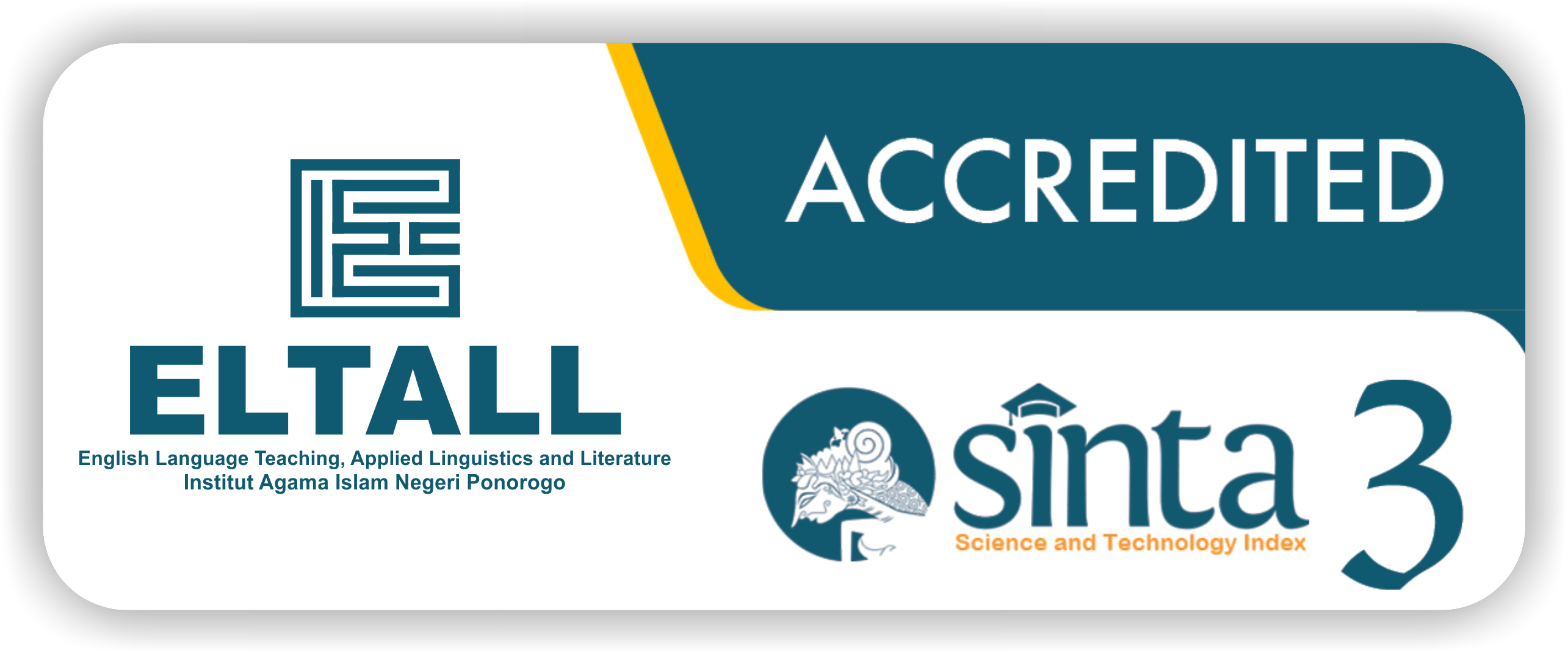STUDENTS’ PERCEPTIONS ON A MULTIMODAL DIGITAL STORYTELLING BOOK USE IN A WRITING CLASS DURING COVID-19 PANDEMIC
DOI:
https://doi.org/10.21154/eltall.v4i01.5451Keywords:
multimodal digital storytelling book, students’ perceptions, writing classAbstract
This study aimed to describe the students’ perceptions toward the use of a multimodal digital storytelling book in the writing class during COVID-19 pandemic. This research used a descriptive qualitative design. Meanwhile, the participants of this study were twenty students in the second semester of an English language education department in a private university located in East Java. The data were collected through the closed-ended questionnaires which were shared through Google Form. These questionnaires consisted of seven statements related to the use of a multimodal digital storytelling book in their writing class. After all the data were collected, then, the data were tabulated and calculated its frequency for each questionnaire item. The results of questionnaire analysis revealed that more than 85% of the students gave positive perceptions toward the use of a multimodal digital storytelling book in their writing class. Hopefully, the results of this study can become a reference for English teachers especially and language teachers generally when they teach writing online.
References
Akbarjono, A., Belawati, E., & Afriani, Z. L. (2022). Students’ enthusiasm in learning in the COVID-19 outbreak. Journal of Research on Language Education (JoRLE), 3(1), 15~19. Retrieved from https://ejurnal.teknokrat.ac.id/index.php/JoRLE/article/download/1773/795
Atmojo, A. E. P., & Nugroho, A. (2020). EFL classes must go online! teaching activities and challenges during COVID-19 pandemic in Indonesia. Register Journal, 13(1), 49”“76. https://doi.org/10.18326/rgt.v13i1.49-76
Balaman, S. (2018). Digital storytelling: A multimodal narrative writing genre. Journal of Language and Linguistic Studies, 14(3), 202”“212. Retrieved from http://www.jlls.org/index.php/jlls/article/view/996
Brzoska, K. (2020). Learning in the time of COVID-19. Retrieved from https://www.cambridge.org/elt/blog/2020/08/28/learning-time-covid-19/
Buendgens-Kosten, J. (2021). Digital storytelling multimodal meaning making. Innovative Language Pedagogy Report, 103”“108. https://doi.org/10.14705/ rpnet.2021.50.1243
Jones, S., & Chapman, K. (2017). Telling stories: Engaging critical literacy through urban legends in an English secondary school. English Teaching: Practice & Critique, 16, 85”“96. https://doi.org/10.1108/ETPC-02-2016-0031
Ladino, M. M. L. (2017). Multimodal storytelling as moments of critical literacy and multimodal composing in the ESL preschool classroom. Universidad Pontificia Bolivariana.
Lestariyana, R. P. D., & Widodo, H. P. (2018). Engaging young learners of English with digital stories: Learning to mean. Indonesian Journal of Applied Linguistics, 8(2), 489”“495. https://doi.org/10.17509/ijal.v8i2.13314
Mardiansyah, R. (2018). A Correlation between Self-Confidence and Essay Writing Achievement. Edukasi: Jurnal Pendidikan Dan Pengajaran, 5(2), 154”“166. https://doi.org/10.19109/ejpp.v5i2.2326
Mindaningsih, Wahyudin, U. R., & Bariah, O. (2022). Perspektif guru pendidikan agama Islam mengenai pembelajaran online di masa pandemic Covid 19. Edukatif : Jurnal Ilmu Pendidikan, 4(2), 1969”“1980. https://doi.org/10.31004/edukatif.v4i2
Moleong, L. J. (2012). Metodologi penelitian kualitatif. Bandung: PT Remaja Rosdakarya.
Nugroho, A., & Mutiaraningrum, I. (2020). EFL teachers’ beliefs and practices about digital learning of English. EduLite: Journal of English Education, Literature, and Culture, 5(2), 304”“321. https://doi.org/10.30659/e.5.2.304-321
Puspitasari, D. (2018). the use of digital storytelling (DST) to help students in learning multimodal writing. Leksika, 12(2), 66””71. Retrieved from http://jurnalnasional.ump.ac.id/index.php/LEKSIKA/article/view/3803
Ratnaningsih, S. (2019). The use of image media to increase learning motivation in the field of social sciences in elementary school students. NCOLWIS 2019, August 29-30, Padang, Indonesia, 1”“7. https://doi.org/10.4108/eai.29-8-2019.2289156
Reimers, F., Schleicher, A., Saavedra, J., & Tuominen, S. (2020). Supporting the continuation of teaching and learning during the COVID-19 Pandemic Annotated resources for online learning. OECD. Retrieved from https://www.oecd.org/education/%0ASupporting-the-continuation-of-teaching-and-learning-during-the-COVID-19-%0Apandemic.pdf
Robin, B. R. (2016). The power of digital storytelling to support teaching and learning. Digital Education Review, 30, 17”“29. Retrieved from https://dialnet.unirioja.es/servlet/articulo?codigo=5772440
Sani, R. A., Manurung, S. R., Suswanto, H., & Sudiran. (2018). Penelitian pendidikan. Tangerang: Tira Smart.
United Nations. (2020). Policy Brief: Education during COVID-19 and beyond.
Urbieta, A. S., & Peñalver, E. A. (2021). Multimodal discourse in digital storytelling: An assessment tool proposal. Computer Assisted Language Learning Electronic Journal, 22(2), 14”“25. Retrieved from http://callej.org/journal/22-2/Urbieta-Penalver2021.pdf
Wahyuni, S., & Yulianti, F. (2016). The use of guesing game to improve students’ speaking skill. Getsempena English Education Journal, 3(2), 12”“22. Retrieved from https://www.neliti.com/journals/getsempena-english-education-journal/catalogue
Watrianthos, R., Handayani, R., Hasibuan, R., Ambiyar, & Refdinal. (2022). Students’ perceptions of android-based interactive multimedia in learning biology. Edukatif : Jurnal Ilmu Pendidikan Volume, 4(4), 5010”“5016. https://doi.org/10.31004/edukatif.v4i4.3044
Widodo, H. P. (2016). Engaging young learners of English in a genre-based digital storytelling project. Cambridge: Cambridge University Press Language Teacher Research.
Zuhriyah, M., & Fajarina, M. (2021). Course review horay and critical thinking skills: the effective teaching model for students’ grammar competence in remote EFL classrooms. Journal on English as a Foreign Language, 11(2), 297”“317. https://doi.org/10.23971/jefl.v11i2.2974
Zuhriyah, M., & Fajarina, M. (2022). The effectiveness of blended synchronous and asynchronous learning for teaching reading comprehension. Al-Ishlah: Jurnal Pendidikan, 14(1), 795”“802. https://doi.org/10.35445/alishlah.v14i1.1237
Downloads
Published
Issue
Section
License
Copyright (c) 2023 ELTALL: English Language Teaching, Applied Linguistic and Literature

This work is licensed under a Creative Commons Attribution-NonCommercial 4.0 International License.
All articles published in ELTALL (English Language Teaching, Applied Linguistics, and Literature Journal) are licensed under the Creative Commons Attribution-NonCommercial 4.0 International License (CC BY-NC 4.0).
Under this license, authors and readers are free to:
- Share. copy and redistribute the material in any medium or format
- Adapt. remix, transform, and build upon the material
Under the following terms:
- Attribution. You must give appropriate credit, provide a link to the license, and indicate if changes were made. You may do so in any reasonable manner but not in any way that suggests the licensor endorses you or your use.
- Non-Commercial. You may not use the material for commercial purposes.
Notices:
- The licensor cannot revoke these freedoms as long as you follow the license terms.
- No additional restrictions. You may not apply legal terms or technological measures that legally restrict others from doing anything the license permits.
For the full legal code of the license, please visit: https://creativecommons.org/licenses/by-nc/4.0/













